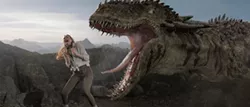
The Bubble and Lost City
THE BUBBLE. It was almost — only? — two years ago that The King of Staten Island, Judd Apatow’s last feature, was released. It felt noteworthy because Apatow’s comedies are events (albeit minor ones for most) in and of themselves and because it was a starring role for Pete Davidson, the anointed one. But it was also momentous for being released straight to streaming while the world, the economy of cinema and our culture wrestled with the realities of life in plague-time. While other major studio releases were pushed back or thrust defiantly into theaters, the small-screen roll-out of The King of Staten Island felt like an acknowledgment not only of a compromised present, but of a future unlikely to resemble even the immediate past. It seemed forward-thinking, which I think is one of the trademarks of Apatow’s sensibility, but also one prong of the dichotomy that defines it. In a number of ways, he is of a generation before his own. Although he is a peer of Adam Sandler and Janeane Garofolo (themselves becoming Ancient Ones by TikTok math), he dedicated himself to the study of the comedy that came before: washing dishes in stand-up clubs as a child, interviewing legends-to-be in his teen years, creating a sort-of dumb-wise-beyond-his-years persona for himself. Transitioning into moviemaking, as a writer-director-producer-talent scout and impresario, he developed a visual style that, in showcasing his casts and their improvisations, was formalistic and old-fashioned. Largely out of necessity, Apatow’s camera is mostly static, his framing wide and his takes extended to enable inventions on set to be cut together into something coherent. Technically speaking, he hasn’t done much to advance the cinematic form. But by leaning into traditional technique, Apatow created a forum within which he could change and evolve movie comedy. Jokes can happen organically, emerging from the interplay of quick-minded performers, clever screenplays and sets with enough air in them for the creation of the unexpected. To date, Apatow movies have also relied on a near-biographical narrative intimacy, focusing on the vagaries of the inner lives of a main character or two, with casts of supporting characters who, despite feeling real and being allowed their funny moments, were not necessarily burdened with bearing the load of story. The Bubble, (co-written with Pam Brady) is the story of the troubled, COVID-restricted production (in rural England) of a major studio’s monster movie. (Apparently it was…

